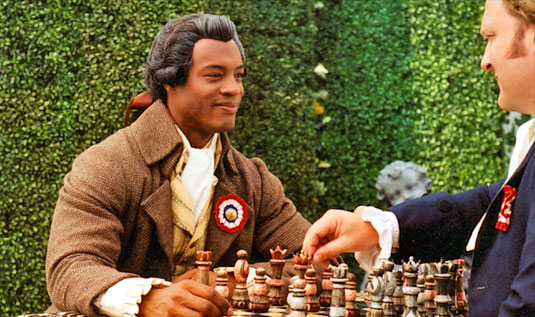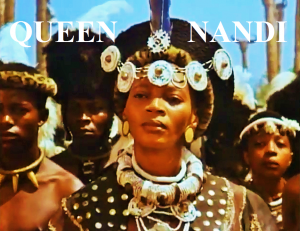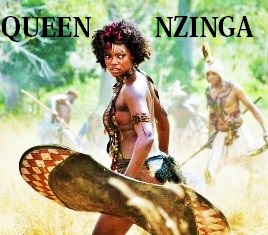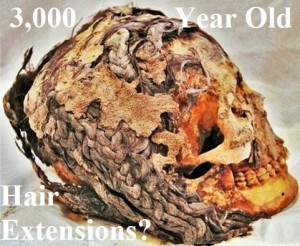Before Prince there was Le Mozart Noir / Joseph Boulogne, Le Chevalier Saint Georges portrays the remarkable life of a man who overcame the adversities of class, race and society to become a international superstar in 18th century France whose work has fallen into neglect due to the prejudices of history.

–Marie Antoinette -film still 2006
His musical compositions inspired Mozart, Haydn and Beethoven. As if that weren’t enough, Saint-Georges was also France’s finest fencer, a famed lover, and a General who led an army of 1000 black soldiers in the French Revolution – unprecedented in European history.

–tafelmusik.org/concert-calendar/events/le-mozart-noir
Born in Guadeloupe, he was the son of George Bologne de Saint-Georges, a wealthy planter, and Nanon, his African slave.
Guadeloupe, like the other overseas departments, is an integral part of France. It is thus part of the European Union and the Eurozone, and its currency is the euro. As an overseas department, Guadeloupe is not part of the Schengen Area. The prefecture (regional capital) of Guadeloupe is the city of Basse-Terre, which lies on the island of the same name. The official language is French, and virtually the entire population except recent arrivals from metropolitan France also speaks Antillean Creole (Créole Guadeloupéen).

During the French Revolution, Saint-Georges was colonel of the Légion St.-Georges, the first all-black regiment in Europe, fighting on the side of the Republic. Today the Chevalier de Saint-Georges is best remembered as the first classical composer of African ancestry.

academicvideostore.com/video/le-mozart-noir-reviving-legend
In 1773, when Gossec took over the direction of the prestigious but troubled Concert Spirituel, he designated Saint-Georges as his successor as director of the Concert des Amateurs. Less than two years under his direction, “Performing with great precision and delicate nuances [the Amateurs] became the best orchestra for symphonies in Paris, and perhaps in all of Europe.” As the Queen attended some of Saint-Georges’ concerts at the Palais de Soubise, arriving sometimes without notice, the orchestra wore court attire for all its performances. “Dressed in rich velvet or damask with gold or silver braid and fine lace on their cuffs and collars and with their parade swords and plumed hats placed next to them on their benches, the combined effect was as pleasing to the eye as it was flattering to the ear.” Saint-Georges played all his violin concertos as soloist with his orchestra. Their corner movements are replete with daring batteries and bariolages, brilliant technical effects made possible by the new bow designed by Nicholas Pierre Tourte Père – a perfect foil in the hands of a great swordsman. While their fast movements reveal the composer probing the outer limits of his instrument, his slow movements are lyrical and expressive, with an occasional touch of Creole nostalgia.

In 1776 the Académie royale de musique, the (Paris Opéra), was once again in dire straits. Saint Georges was proposed as the next director of the opera. As creator of the first disciplined French orchestra since Lully, he was the obvious choice to rescue the prestige of that troubled institution. However, alarmed by his reputation as a taskmaster, three of its leading ladies “… presented a placet (petition) to the Queen [Marie Antoinette] assuring her Majesty that their honor and delicate conscience could never allow them to submit to the orders of a mulatto.” To keep the affair from embarrassing the queen, Saint-Georges promptly withdrew his name from the proposal. Meanwhile, to defuse the brewing scandal, Louis XVI took the Opéra back from the city of Paris – ceded to it by Louis XIV a century ago – to be managed by his Intendant of Light Entertainments. Following the “affair,” Marie-Antoinette preferred to hold her musicales in the salon of her petit appartement de la reine in Versailles. The audience was limited to her intimate circle and only a few musicians, among them the Chevalier de Saint-Georges. “Invited to play music with the queen,” Saint-Georges probably played his violin sonatas, with her Majesty playing the forte-piano.
Mozart spent over two months under the same roof with Saint-Georges, confirms that they knew each other.
Joseph Boulogne Chevalier de Saint-George Biography – life, children …

–le-mozart-noir-reviving-a-legend
Broadcast on the CBC, BBC, TV5 and ARTV among others. Worldwide distribution by Media Headquarters. Home video and Juno-nominated soundtrack album distributed worldwide by CBC Records.
Winner, Banff World Television Award
Finalist, The Golden Rose of Montreux
5 Gemini Award Nominations
Saint-Georges%3A+Violin+Concertos
Saint-Georges: 8 Symphonies Concertantes Below

–Wiki
Le Mozart Noir / Joseph Boulogne, Le Chevalier Saint Georges

Guadeloupe (/ɡwɑːdəˈluːp/; French pronunciation: [ɡwadəlup]; Antillean Creole: Gwadloup) is an insular region of France located in the Leeward Islands, part of the Lesser Antilles in the Caribbean. Administratively, it is an overseas region consisting of a single overseas department. It has a land area of 1,628 square kilometres (629 sq. mi) and a population of 403,750 (as of January 2014).
Guadeloupe’s two main islands are Basse-Terre to the west and Grande-Terre to the east, which are separated by a narrow strait that is crossed with bridges. They are often referred to as a single island. The department also includes the Dependencies of Guadeloupe which include the smaller islands of Marie-Galante and La Désirade, and the Îles des Saintes.
The island was called “Karukera” (or “The Island of Beautiful Waters”) by the Arawak people, who settled on there in 300 AD/CE. During the 8th century, the Caribs came and killed the existing population of Amerindians on the island.
During his second trip to the Americas, in November 1493, Christopher Columbus became the first European to land on Guadeloupe, while seeking fresh water. He called it Santa María de Guadalupe de Extremadura, after the image of the Virgin Mary venerated at the Spanish monastery of Villuercas, in Guadalupe, Extremadura. The expedition set ashore just south of Capesterre, but left no settlers behind.
During the 17th century, the Caribs fought against the Spanish settlers and repelled them.
After successful settlement on the island of St. Christophe (St. Kitts), the French Company of the American Islands delegated Charles Lienard (Liénard de L’Olive) and Jean Duplessis Ossonville, Lord of Ossonville to colonize one or any of the region’s islands, Guadeloupe, Martinique, or Dominica.
Due to Martinique’s inhospitable nature, the duo resolved to settle in Guadeloupe in 1635, took possession of the island, and wiped out many of the Carib Amerindians. It was annexed to the kingdom of France in 1674.
































































 Take care of your body, it's the only
Take care of your body, it's the only








































